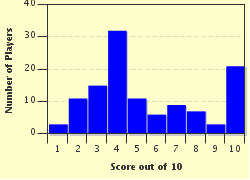Quiz Answer Key and Fun Facts
1. As with nuclear explosions, the explosive yield of volcanic eruptions can also be measured in megatons. Place these volcanic and nuclear explosions in order according to how powerful their blasts were, from largest to smallest.
2. Which of the following nuclear test bursts was labeled the world's first nuclear disaster because of the radiological poisoning/fallout?
3. In nuclear weapons tests, what is a "fizzle?"
4. A fizzle can be very powerful.
5. The George device of Operation Greenhouse was detonated in May 1951 at Eniwetok Atoll. What was this the first-ever successful use of?
6. What did J. Robert Oppenheimer famously say after the Trinity test?
7. What was the name of the missile that the U.S. used to test nuclear explosions high in the atmosphere?
8. The United States used several different platforms on which nuclear weapons were detonated. Which of the following was NOT used?
9. Which of the following did not result from the high-altitude 1962 Operation Starfish Prime test, which was exploded 250 miles over Johnston Island in the South Pacific?
10. Which USAF bomber dropped the first air-delivered H-bomb?
Source: Author
ShilohGrant
This quiz was reviewed by FunTrivia editor
bloomsby before going online.
Any errors found in FunTrivia content are routinely corrected through our feedback system.

